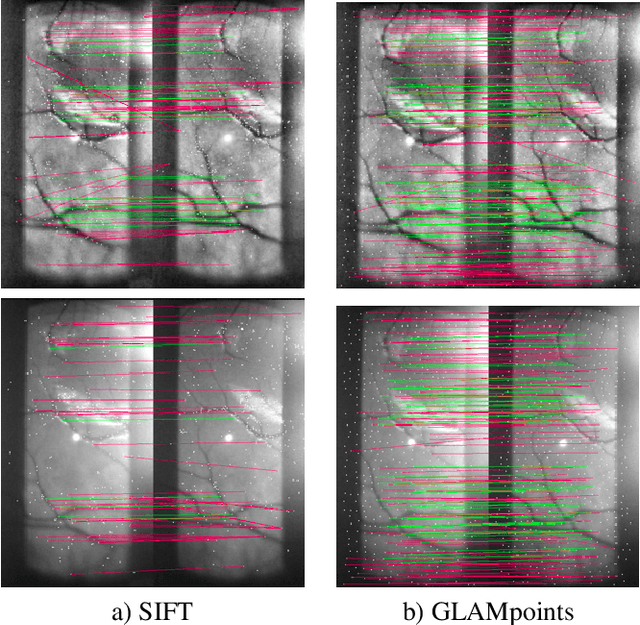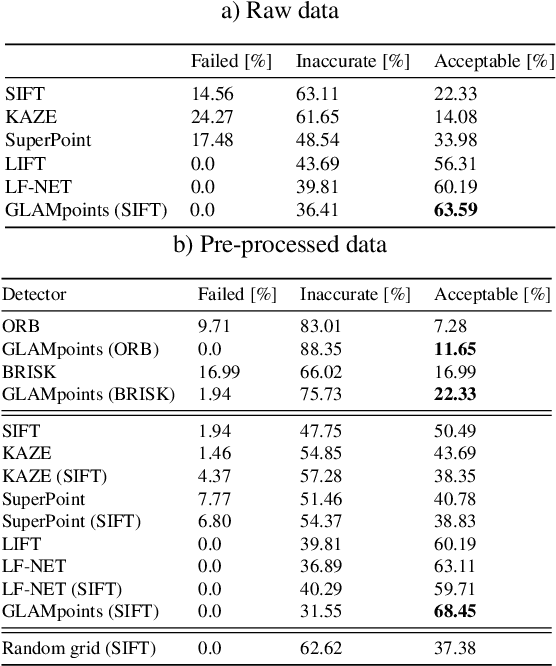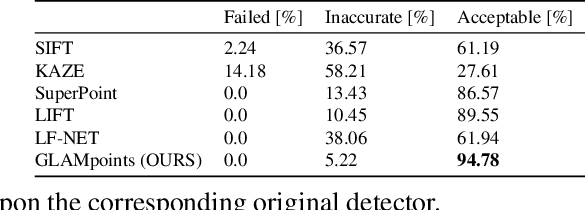Prune Truong
SPARF: Neural Radiance Fields from Sparse and Noisy Poses
Nov 21, 2022



Abstract:Neural Radiance Field (NeRF) has recently emerged as a powerful representation to synthesize photorealistic novel views. While showing impressive performance, it relies on the availability of dense input views with highly accurate camera poses, thus limiting its application in real-world scenarios. In this work, we introduce Sparse Pose Adjusting Radiance Field (SPARF), to address the challenge of novel-view synthesis given only few wide-baseline input images (as low as 3) with noisy camera poses. Our approach exploits multi-view geometry constraints in order to jointly learn the NeRF and refine the camera poses. By relying on pixel matches extracted between the input views, our multi-view correspondence objective enforces the optimized scene and camera poses to converge to a global and geometrically accurate solution. Our depth consistency loss further encourages the reconstructed scene to be consistent from any viewpoint. Our approach sets a new state of the art in the sparse-view regime on multiple challenging datasets.
Refign: Align and Refine for Adaptation of Semantic Segmentation to Adverse Conditions
Jul 14, 2022



Abstract:Due to the scarcity of dense pixel-level semantic annotations for images recorded in adverse visual conditions, there has been a keen interest in unsupervised domain adaptation (UDA) for the semantic segmentation of such images. UDA adapts models trained on normal conditions to the target adverse-condition domains. Meanwhile, multiple datasets with driving scenes provide corresponding images of the same scenes across multiple conditions, which can serve as a form of weak supervision for domain adaptation. We propose Refign, a generic extension to self-training-based UDA methods which leverages these cross-domain correspondences. Refign consists of two steps: (1) aligning the normal-condition image to the corresponding adverse-condition image using an uncertainty-aware dense matching network, and (2) refining the adverse prediction with the normal prediction using an adaptive label correction mechanism. We design custom modules to streamline both steps and set the new state of the art for domain-adaptive semantic segmentation on several adverse-condition benchmarks, including ACDC and Dark Zurich. The approach introduces no extra training parameters, minimal computational overhead -- during training only -- and can be used as a drop-in extension to improve any given self-training-based UDA method. Code is available at https://github.com/brdav/refign.
Probabilistic Warp Consistency for Weakly-Supervised Semantic Correspondences
Mar 08, 2022



Abstract:We propose Probabilistic Warp Consistency, a weakly-supervised learning objective for semantic matching. Our approach directly supervises the dense matching scores predicted by the network, encoded as a conditional probability distribution. We first construct an image triplet by applying a known warp to one of the images in a pair depicting different instances of the same object class. Our probabilistic learning objectives are then derived using the constraints arising from the resulting image triplet. We further account for occlusion and background clutter present in real image pairs by extending our probabilistic output space with a learnable unmatched state. To supervise it, we design an objective between image pairs depicting different object classes. We validate our method by applying it to four recent semantic matching architectures. Our weakly-supervised approach sets a new state-of-the-art on four challenging semantic matching benchmarks. Lastly, we demonstrate that our objective also brings substantial improvements in the strongly-supervised regime, when combined with keypoint annotations.
* Accepted at CVPR 2022 code: https://github.com/PruneTruong/DenseMatching
PDC-Net+: Enhanced Probabilistic Dense Correspondence Network
Sep 29, 2021



Abstract:Establishing robust and accurate correspondences between a pair of images is a long-standing computer vision problem with numerous applications. While classically dominated by sparse methods, emerging dense approaches offer a compelling alternative paradigm that avoids the keypoint detection step. However, dense flow estimation is often inaccurate in the case of large displacements, occlusions, or homogeneous regions. In order to apply dense methods to real-world applications, such as pose estimation, image manipulation, or 3D reconstruction, it is therefore crucial to estimate the confidence of the predicted matches. We propose the Enhanced Probabilistic Dense Correspondence Network, PDC-Net+, capable of estimating accurate dense correspondences along with a reliable confidence map. We develop a flexible probabilistic approach that jointly learns the flow prediction and its uncertainty. In particular, we parametrize the predictive distribution as a constrained mixture model, ensuring better modelling of both accurate flow predictions and outliers. Moreover, we develop an architecture and an enhanced training strategy tailored for robust and generalizable uncertainty prediction in the context of self-supervised training. Our approach obtains state-of-the-art results on multiple challenging geometric matching and optical flow datasets. We further validate the usefulness of our probabilistic confidence estimation for the tasks of pose estimation, 3D reconstruction, image-based localization, and image retrieval. Code and models are available at https://github.com/PruneTruong/DenseMatching.
Warp Consistency for Unsupervised Learning of Dense Correspondences
Apr 08, 2021



Abstract:The key challenge in learning dense correspondences lies in the lack of ground-truth matches for real image pairs. While photometric consistency losses provide unsupervised alternatives, they struggle with large appearance changes, which are ubiquitous in geometric and semantic matching tasks. Moreover, methods relying on synthetic training pairs often suffer from poor generalisation to real data. We propose Warp Consistency, an unsupervised learning objective for dense correspondence regression. Our objective is effective even in settings with large appearance and view-point changes. Given a pair of real images, we first construct an image triplet by applying a randomly sampled warp to one of the original images. We derive and analyze all flow-consistency constraints arising between the triplet. From our observations and empirical results, we design a general unsupervised objective employing two of the derived constraints. We validate our warp consistency loss by training three recent dense correspondence networks for the geometric and semantic matching tasks. Our approach sets a new state-of-the-art on several challenging benchmarks, including MegaDepth, RobotCar and TSS. Code and models will be released at https://github.com/PruneTruong/DenseMatching.
Learning Accurate Dense Correspondences and When to Trust Them
Jan 05, 2021



Abstract:Establishing dense correspondences between a pair of images is an important and general problem. However, dense flow estimation is often inaccurate in the case of large displacements or homogeneous regions. For most applications and down-steam tasks, such as pose estimation, image manipulation, or 3D reconstruction, it is crucial to know when and where to trust the estimated correspondences. In this work, we aim to estimate a dense flow field relating two images, coupled with a robust pixel-wise confidence map indicating the reliability and accuracy of the prediction. We develop a flexible probabilistic approach that jointly learns the flow prediction and its uncertainty. In particular, we parametrize the predictive distribution as a constrained mixture model, ensuring better modelling of both accurate flow predictions and outliers. Moreover, we develop an architecture and training strategy tailored for robust and generalizable uncertainty prediction in the context of self-supervised training. Our approach obtains state-of-the-art results on multiple challenging geometric matching and optical flow datasets. We further validate the usefulness of our probabilistic confidence estimation for the task of pose estimation. Code and models will be released at github.com/PruneTruong/PDCNet.
GOCor: Bringing Globally Optimized Correspondence Volumes into Your Neural Network
Sep 16, 2020



Abstract:The feature correlation layer serves as a key neural network module in numerous computer vision problems that involve dense correspondences between image pairs. It predicts a correspondence volume by evaluating dense scalar products between feature vectors extracted from pairs of locations in two images. However, this point-to-point feature comparison is insufficient when disambiguating multiple similar regions in an image, severely affecting the performance of the end task. We propose GOCor, a fully differentiable dense matching module, acting as a direct replacement to the feature correlation layer. The correspondence volume generated by our module is the result of an internal optimization procedure that explicitly accounts for similar regions in the scene. Moreover, our approach is capable of effectively learning spatial matching priors to resolve further matching ambiguities. We analyze our GOCor module in extensive ablative experiments. When integrated into state-of-the-art networks, our approach significantly outperforms the feature correlation layer for the tasks of geometric matching, optical flow, and dense semantic matching. The code and trained models will be made available at github.com/PruneTruong/GOCor.
GLU-Net: Global-Local Universal Network for Dense Flow and Correspondences
Dec 11, 2019



Abstract:Establishing dense correspondences between a pair of images is an important and general problem, covering geometric matching, optical flow and semantic correspondences. While these applications share fundamental challenges, such as large displacements, pixel-accuracy, and appearance changes, they are currently addressed with specialized network architectures, designed for only one particular task. This severely limits the generalization capabilities of such networks to new scenarios, where e.g. robustness to larger displacements or higher accuracy is required. In this work, we propose a universal network architecture that is directly applicable to all the aforementioned dense correspondence problems. We achieve both high accuracy and robustness to large displacements by investigating the combined use of global and local correlation layers. We further propose an adaptive resolution strategy, allowing our network to operate on virtually any input image resolution. The proposed GLU-Net achieves state-of-the-art performance for geometric and semantic matching as well as optical flow, when using the same network and weights.
GLAMpoints: Greedily Learned Accurate Match points
Aug 19, 2019



Abstract:We introduce a novel CNN-based feature point detector - GLAMpoints - learned in a semi-supervised manner. Our detector extracts repeatable, stable interest points with a dense coverage, specifically designed to maximize the correct matching in a specific domain, which is in contrast to conventional techniques that optimize indirect metrics. In this paper, we apply our method on challenging retinal slitlamp images, for which classical detectors yield unsatisfactory results due to low image quality and insufficient amount of low-level features. We show that GLAMpoints significantly outperforms classical detectors as well as state-of-the-art CNN-based methods in matching and registration quality for retinal images.
 Add to Chrome
Add to Chrome Add to Firefox
Add to Firefox Add to Edge
Add to Edge